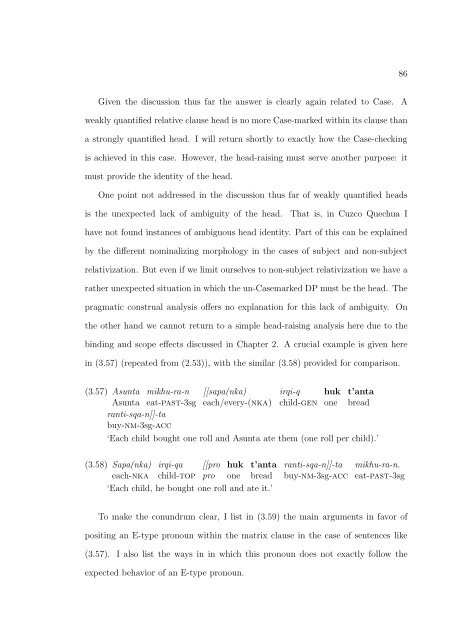the syntax and semantics of relativization and quantification
the syntax and semantics of relativization and quantification
the syntax and semantics of relativization and quantification
You also want an ePaper? Increase the reach of your titles
YUMPU automatically turns print PDFs into web optimized ePapers that Google loves.
86<br />
Given <strong>the</strong> discussion thus far <strong>the</strong> answer is clearly again related to Case. A<br />
weakly quantified relative clause head is no more Case-marked within its clause than<br />
a strongly quantified head. I will return shortly to exactly how <strong>the</strong> Case-checking<br />
is achieved in this case. However, <strong>the</strong> head-raising must serve ano<strong>the</strong>r purpose: it<br />
must provide <strong>the</strong> identity <strong>of</strong> <strong>the</strong> head.<br />
One point not addressed in <strong>the</strong> discussion thus far <strong>of</strong> weakly quantified heads<br />
is <strong>the</strong> unexpected lack <strong>of</strong> ambiguity <strong>of</strong> <strong>the</strong> head. That is, in Cuzco Quechua I<br />
have not found instances <strong>of</strong> ambiguous head identity. Part <strong>of</strong> this can be explained<br />
by <strong>the</strong> different nominalizing morphology in <strong>the</strong> cases <strong>of</strong> subject <strong>and</strong> non-subject<br />
<strong>relativization</strong>. But even if we limit ourselves to non-subject <strong>relativization</strong> we have a<br />
ra<strong>the</strong>r unexpected situation in which <strong>the</strong> un-Casemarked DP must be <strong>the</strong> head. The<br />
pragmatic construal analysis <strong>of</strong>fers no explanation for this lack <strong>of</strong> ambiguity. On<br />
<strong>the</strong> o<strong>the</strong>r h<strong>and</strong> we cannot return to a simple head-raising analysis here due to <strong>the</strong><br />
binding <strong>and</strong> scope effects discussed in Chapter 2. A crucial example is given here<br />
in (3.57) (repeated from (2.53)), with <strong>the</strong> similar (3.58) provided for comparison.<br />
(3.57) Asunta mikhu-ra-n<br />
Asunta eat-past-3sg<br />
ranti-sqa-n]]-ta<br />
buy-nm-3sg-acc<br />
[[sapa(nka)<br />
each/every-(nka)<br />
irqi-q<br />
child-gen<br />
huk<br />
one<br />
t’anta<br />
bread<br />
‘Each child bought one roll <strong>and</strong> Asunta ate <strong>the</strong>m (one roll per child).’<br />
(3.58) Sapa(nka) irqi-qa [[pro huk t’anta<br />
each-nka child-top pro one bread<br />
‘Each child, he bought one roll <strong>and</strong> ate it.’<br />
ranti-sqa-n]]-ta<br />
buy-nm-3sg-acc<br />
mikhu-ra-n.<br />
eat-past-3sg<br />
To make <strong>the</strong> conundrum clear, I list in (3.59) <strong>the</strong> main arguments in favor <strong>of</strong><br />
positing an E-type pronoun within <strong>the</strong> matrix clause in <strong>the</strong> case <strong>of</strong> sentences like<br />
(3.57). I also list <strong>the</strong> ways in in which this pronoun does not exactly follow <strong>the</strong><br />
expected behavior <strong>of</strong> an E-type pronoun.
















